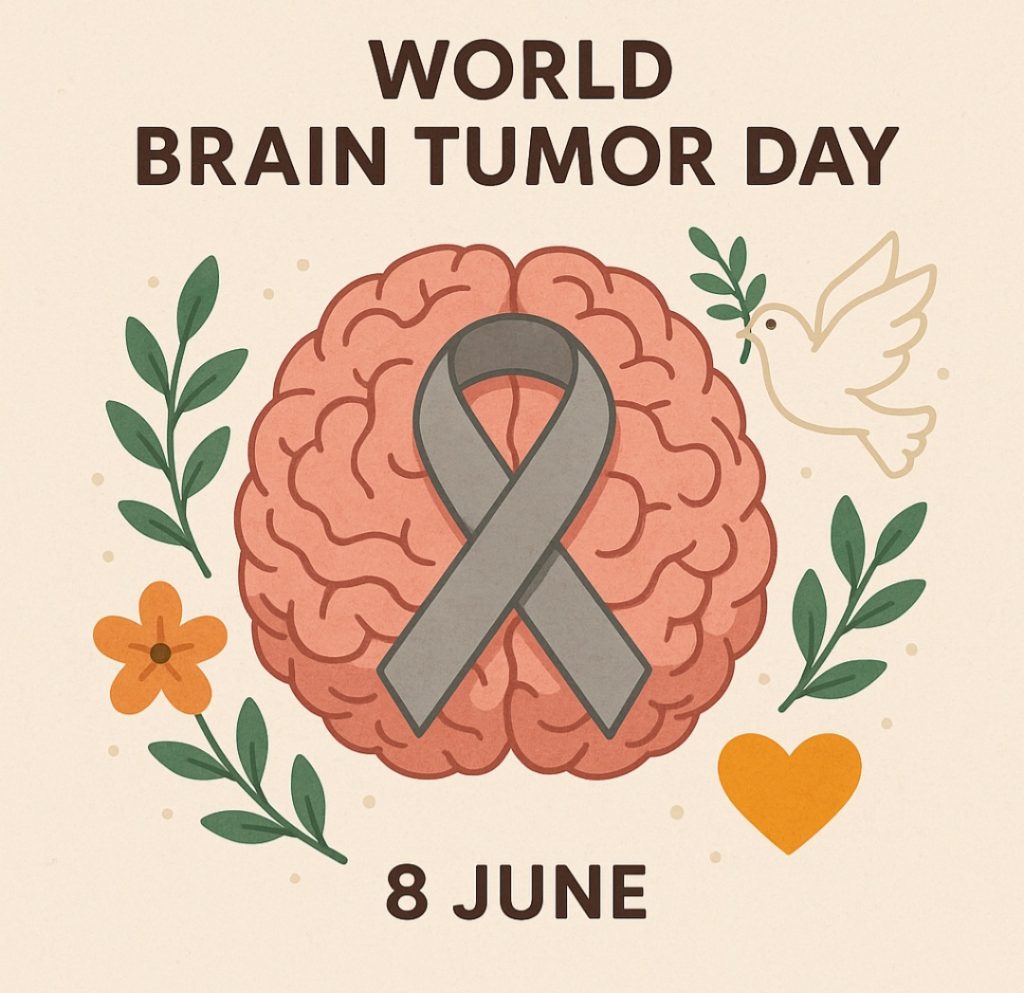Every year on June 8, the world observes World Brain Tumor Day – a day dedicated to raising awareness about brain tumours, supporting patients and families, and advocating for better research and treatments. Brain tumours, though relatively rare, can be devastating, affecting people of all ages—from children to older adults.
This day serves as a crucial reminder of the challenges faced by those diagnosed with brain tumours and the importance of early detection, advanced treatment, and compassionate care.

Understanding Brain Tumours: Types and Causes
On World Brain Tumor Day, let’s recapitulate our knoledge.
A brain tumour is an abnormal growth of cells in the brain or surrounding tissues. They can be benign (non-cancerous) or malignant (cancerous), but even benign tumours can be dangerous if they press against critical brain structures.
Types of Brain Tumours
- Primary Brain Tumours – Originate in the brain. Common types include:
- Gliomas (e.g., glioblastoma, astrocytoma) – Often aggressive.
- Meningiomas – Usually benign but can cause symptoms.
- Pituitary adenomas – Affect hormone-producing glands.
- Secondary (Metastatic) Brain Tumours – Spread from cancers elsewhere in the body (e.g., lung, breast).
According to the World Health Organization (WHO), brain tumours account for 1-2% of all cancers, but their impact is profound due to their location and effects on cognition, movement, and personality.
Risk Factors
While the exact causes are unclear, risk factors include:
- Exposure to radiation.
- Genetic conditions (e.g., neurofibromatosis).
- Family history (rare).
Recognizing the Symptoms: When to Seek Help
Symptoms vary depending on tumour size and location but may include:
- Persistent headaches (often worse in the morning).
- Seizures (sudden, uncontrolled brain activity).
- Nausea or vomiting (without cause).
- Vision/hearing problems.
- Personality or memory changes.
- Difficulty with balance or speech.
Early diagnosis improves outcomes. If symptoms persist, consult a neurologist.
Diagnosis and Treatment Options
Diagnosis
Doctors use:
- MRI and CT scans – Detailed brain imaging.
- Biopsy – Tissue sample analysis.
- Neurological exams – Assess brain function.
Treatment Approaches
Treatment depends on tumour type, size, and location:
- Surgery – Removal of accessible tumours.
- Radiation Therapy – Targets cancer cells with high-energy beams.
- Chemotherapy – Drugs to slow tumour growth.
- Targeted Therapy & Immunotherapy – Newer treatments focusing on specific tumour markers.
Despite advancements, glioblastoma, an aggressive brain cancer, has a five-year survival rate of only 5-10%, highlighting the need for more research.
The Emotional and Social Impact
A brain tumour diagnosis affects patients and families deeply. Cognitive changes, physical disabilities, and emotional distress can strain relationships. Support groups and organizations like the International Brain Tumour Alliance (IBTA) provide crucial help.
Case Study: A Survivor’s Journey
Sarah, diagnosed with a benign meningioma at 32, faced memory lapses post-surgery. With therapy and support, she regained independence—proof recovery is possible with proper care.
How You Can Help
World Brain Tumour Day is about action. Here’s how to contribute:
- ✅ Educate Yourself & Others – Share facts about symptoms and treatments.
- ✅ Support Research – Donate to organizations like the American Brain Tumor Association (ABTA).
- ✅ Advocate for Patients – Push for better healthcare policies.
- ✅ Show Compassion – Offer emotional support to affected families.
Conclusion: A Day of Solidarity and Hope
Brain tumours are complex, but awareness and research bring hope. On June 8, let’s honor survivors, remember those lost, and push for breakthroughs. Whether through donations, advocacy, or spreading knowledge, every effort counts.
Together, we can make a difference.
Final Thoughts
Want to get involved? Check out brain tumour awareness campaigns or connect with support networks. Knowledge is power—let’s use it to fight brain tumours.
Can Ayurveda Help ?
While conventional medicine remains the primary approach for brain tumor treatment, Ayurveda offers a complementary perspective, focusing on balancing the body’s doshas and enhancing natural healing. Ayurvedic practices utilize specific herbs like Ashwagandha, Turmeric, and Guduchi, known for their anti-inflammatory, antioxidant, and immune-modulatory properties. These remedies, alongside dietary modifications, yoga, meditation, and Panchakarma therapies, aim to alleviate symptoms, improve quality of life, and potentially support the body’s response to conventional treatments, though complete dissolution of tumors by Ayurveda alone is generally not emphasized in mainstream understanding.
हिन्दी रूपान्तरण:-
8 जून: विश्व ब्रेन ट्यूमर दिवस – जागरूकता और आशा का दिन
हर वर्ष 8 जून को विश्व ब्रेन ट्यूमर दिवस मनाया जाता है। यह दिन ब्रेन ट्यूमर के बारे में जागरूकता फैलाने, रोगियों और उनके परिवारों को समर्थन देने, तथा बेहतर शोध और उपचार की वकालत करने के लिए समर्पित है। ब्रेन ट्यूमर अपेक्षाकृत दुर्लभ होते हैं, लेकिन ये किसी भी उम्र के व्यक्ति को प्रभावित कर सकते हैं – बच्चों से लेकर वृद्धों तक।
ब्रेन ट्यूमर क्या है?
ब्रेन ट्यूमर मस्तिष्क या उसके आसपास के ऊतकों में कोशिकाओं की असामान्य वृद्धि है। सभी ट्यूमर कैंसरयुक्त नहीं होते – कुछ बिनाइन (गैर-कैंसरस) होते हैं, जबकि कुछ मैलिग्नेंट (कैंसरस) होते हैं। ये मस्तिष्क के महत्वपूर्ण हिस्सों पर दबाव डालकर शारीरिक, संज्ञानात्मक, या भावनात्मक समस्याएँ पैदा कर सकते हैं।
प्रमुख लक्षण
लगातार सिरदर्द (खासकर सुबह के समय)
दौरे पड़ना (मस्तिष्क में अचानक विद्युत गड़बड़ी)
बिना कारण उल्टी या मतली
दिखाई या सुनाई देने में समस्या
व्यक्तित्व या याददाश्त में बदलाव
निदान और उपचार
उपचार ट्यूमर के प्रकार, आकार और स्थान पर निर्भर करता है:
सर्जरी: ट्यूमर को निकालना (यदि संभव हो)।
रेडिएशन थेरेपी: कैंसर कोशिकाओं को नष्ट करने के लिए उच्च-ऊर्जा किरणें।
कीमोथेरेपी: ट्यूमर की वृद्धि को रोकने वाली दवाएँ।
टार्गेटेड थेरेपी: ट्यूमर के विशिष्ट मार्करों पर केंद्रित नए उपचार
आप कैसे मदद कर सकते हैं?
शिक्षित हों: ब्रेन ट्यूमर के लक्षणों और उपचारों के बारे में जानें।
दान दें: शोध और रोगी सहायता संगठनों को समर्थन दें।
रोगियों के लिए आवाज़ उठाएँ: बेहतर स्वास्थ्य नीतियों की मांग करें।
मिलकर, हम बदलाव ला सकते हैं।